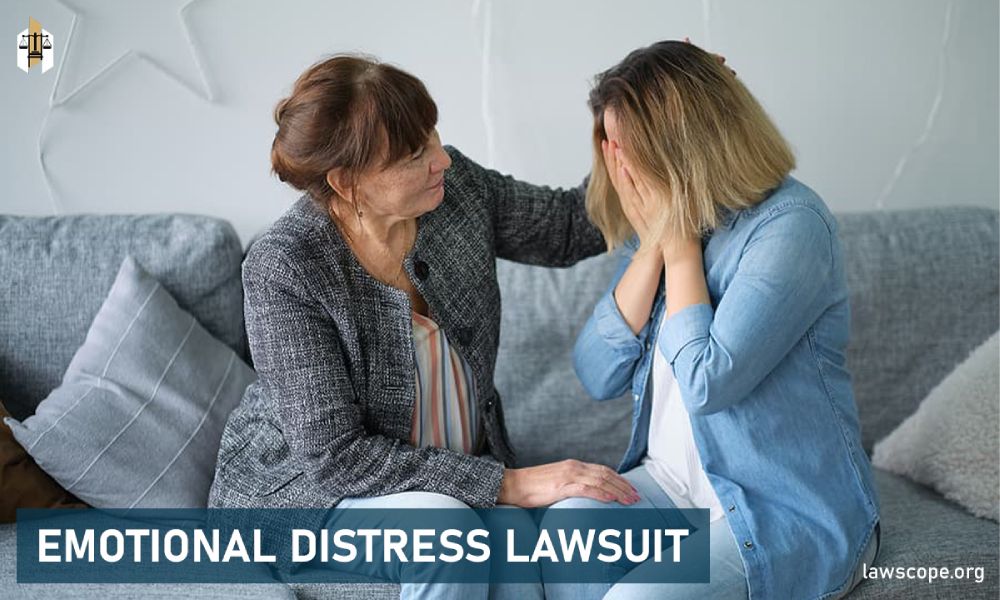
Emotional health is as important as our physical health. In our lives, several incidents happen that not only leave us with physical injuries or scars but also make us emotionally distressed. And that is when you can think of filing an emotional distress lawsuit.
But as these things are all in your mind, things are not as simple as any other lawsuits. There are a lot of things to take care of in the proper manner so that you can get a fair claim.
Only an experienced emotional distress lawyer can help you with that. Here in this article, we will educate you about the lawsuit for emotional distress 101.
What is Emotional Distress?
Emotional distress is like an invisible pain in your mind, making you feel really bad. To put it simply, it’s when someone else’s actions, whether on purpose or by accident, cause your mental suffering.
Imagine feeling sad, anxious, guilty, or unable to sleep because of something someone did to you. Here are some of the symptoms of emotional distress.
- Uncontrollable crying.
- Weight loss or weight gain.
- Chronic headaches.
- Flashbacks.
- Nightmares or insomnia.
- Fatigue.
- Guilt or shame.
- Anxiety.
- Depression.
Let’s take a car accident as an example to understand this better:
- People are supposed to drive safely on the road, following the rules.
- But sometimes, someone drives recklessly, like speeding or running a stop sign.
- When this recklessness leads to harm, that’s when emotional distress comes into play. You might feel really upset because of the accident.
- The harm can also include damage to your car or physical injuries, and there are ways to put a value on this suffering.
But here’s the thing: emotional distress doesn’t always have to be connected to physical injuries. It can be diagnosed as things like anxiety or depression, even if you weren’t physically hurt in the accident.
You can also take legal action for emotional distress if someone deliberately tried to make you feel bad, like in cases of harassment or defamation.
There are two main types of emotional distress claims:
Negligent Infliction: This is when someone’s actions cause you emotional distress, but you might need some physical symptoms too, like breaking out in hives or trembling, to make a strong case. Some states are more flexible about this than others.
Intentional Infliction: In this type of case, if someone intentionally tried to hurt your feelings, it’s usually enough to take legal action.
So, emotional distress is basically the mental pain caused by someone else’s actions, and you can seek compensation for it in certain situations, even if you didn’t suffer physical harm.
Read Also: Top Assault Lawyer in USA – Get The Legal Help You Need Now
How To File Emotional Distress Lawsuit?
Here are the key points about filing an emotional distress lawsuit.
1. Understanding Statutes of Limitations
Before you begin the process of filing an emotional distress lawsuit, it’s crucial to be aware that each state has its own statute of limitations.
This legal timeframe varies from state to state, with some allowing up to six years, while others permit as little as one year for filing your claim.
2. Finding The Right Attorney
Choosing the right attorney is a pivotal step. Start by seeking recommendations from trusted sources, such as friends, family, or professional connections. Your local bar association can also provide referrals.
Additionally, consider asking any other attorney you may have worked with for a recommendation, as legal circles can often be close-knit.
3. Documenting Your Emotional Distress
One of the initial actions in pursuing an emotional distress lawsuit is to meticulously document your stress and any related physical symptoms.
These physical manifestations can significantly strengthen your case.
4. Consulting with an Attorney
After gathering sufficient evidence, schedule a meeting with an attorney. Your attorney will assess your evidence, determining the viability of your case.
They can also guide you in collecting more evidence and preparing for the impending legal process.
5. Pre-Trial Preparations
With your attorney’s assistance, the next step involves filing a claim for intentional infliction of emotional distress. Following this, the defendant will be served, and the trial preparation phase will commence.
This phase includes the process of discovery, involving the exchange of information, depositions, document sharing, and written questions and answers.
6. The Trial and Settlements
A trial date set by the court will eventually arrive. Your attorney will present evidence supporting your emotional distress claim and challenge any defenses put forth by the opposing side.
A trial concludes after both sides have presented their case, and a verdict is reached, either by the jury or the judge.
However, it’s important to note that at any point during this process, a settlement offer may be on the table.
You and your attorney may approach the defendant regarding a settlement even before filing the lawsuit.
Similarly, the defendant might initiate settlement negotiations during pretrial preparations, after the trial has started, or even while the jury is deliberating.
Read Also: Insightful Catastrophic Injury Lawyer | Your Guide to Legal Justice
Building a Strong Case For Emotional Distress Claims
Formating a proper emotional distress lawsuit is not at all an easy task. There are a lot of things that one needs to consider. If you have a lawyer, the professional will handle everything on your behalf.
Still, it will be beneficial if you will get some idea about that. So, here it is.
1. Medical Documentation of Emotional Distress
When someone decides to pursue a personal injury lawsuit due to an injury, it’s likely they’ve sought medical treatment.
During these medical visits, physicians routinely inquire about psychological and emotional symptoms resulting from the injury.
Having emotional distress documented by a medical professional can be a powerful piece of evidence when an attorney argues the case.
2. Maintaining a Personal Journal
We strongly recommend our clients keep a journal or diary to track their daily emotional state. This journal can be as detailed as you wish, documenting both significant emotional shifts and subtle fluctuations. In many instances, these personal notes can serve as valuable evidence in your case.
3. Testimony from Those Close to You
Another avenue for supporting your emotional distress claim is by gathering testimony from people close to you.
This can encompass family members, close friends, or even coworkers who can testify about how your injuries have impacted your emotional well-being.
You Might Like Also: Sexual Assault Lawyer: Addressing the Impact on Mental Health
4. Calculating Emotional Distress Damages
Once your attorney has built a compelling case for emotional distress, they will determine a settlement amount using a method known as the “multiplier method.”
This method involves adding up all tangible or economic damages, such as medical expenses and lost wages.
The sum is then multiplied by a specific factor, typically ranging from 1.5 to 5. This total becomes the proposed settlement amount presented to the at-fault party or their insurer.
May You Like Also: Wrongful Death Attorney: Seeking Justice For Your Claim
Calculating Emotional Distress Lawsuit Settlement Amounts
The compensation for emotional distress depends on the severity of the mental condition and proving liability for personal injury.
Different types of emotional distress and causes exist. Claimants may receive more if it’s intentional or alongside physical harm.
Intentional emotional distress can lead to punitive damages in addition to compensation.
There’s no fixed amount, but a good lawyer can help determine the claim amount and fight for your rights.
You May Like Also:



5 thoughts on “Emotional Distress Lawsuit: Tips and Settlement Amounts”